U Values and R Values
ASHRAE 90.1 Code Compliance
Take a look at what ASHRAE says about fibreglass insulation and how it performs when placed in steel structures. Whether it is steel stud walls or full steel wall with all the connections, joints, and support beams, the benefits of fibreglass are dramatically reduced by engineering standards because it cannot effectively block the lost or gain of heat.
Testing required to prove the R value:
A. ASTM C 236-89 “Standard test method for Steady-State Thermal Performance of building Assemblies by Means of a Guarded Hot Box”.
B. ASTM 1269 “Differential Scanning Calorimeter” ASTM E1461-92 “Thermal Diffusivity”
“Thermal Diffusivity” tests, gives Super Therm precisely the requirements to claim ASHRAE 90.1 compliance. With 250 microns DFT of Super Therm having a “U” (Thermal Flow) value of 0.052, Super Therm exceeds the maximum “U” value of 0.061 required, (remember lower is better). Because the “U” value is used to measure “area-weighted average”, insulated walls or roofs will have a less favourable “U” value than the one suggested by the type of insulation used, here is why:
Metal or wood studs and rafters have less resistance “R” value, as well a higher “U” (Thermal Flow) making the assembly having a lower “R” value than the one proposed by the insulation fillers, glass, foam, etc.
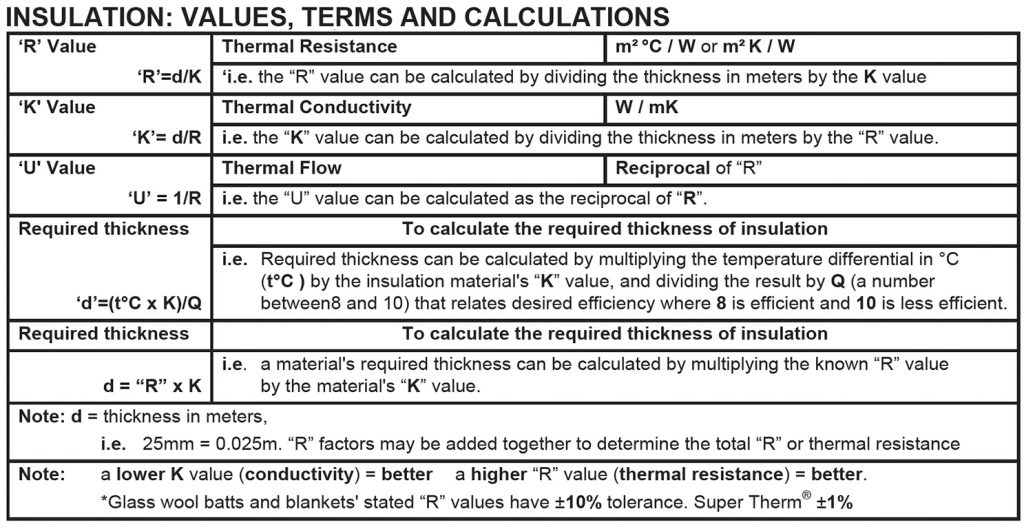
ASHRAE 90.1 Code Compliance Statement
When it is colder on one side of an envelope element, such as a wall, roof, floor, or window, heat will conduct from the warmer side to the cooler side. Heat conduction is driven by temperature differences and is a major component of heating and cooling loads in buildings. The building envelope requirements of the 90.1 Code address heat conduction by specifying minimum R-values (thermal resistance to heat flow) for insulation or maximum U-factors (the rate of steady-state heat flow) for building envelope construction assemblies.
Most insulation is sold on its advertised R-value, but the moment it goes into a real wall system the number collapses. ASHRAE 90.1 is blunt about it: steel frames, metal studs, sheathing and thermal bridges can strip 30% or more off the stated performance. In metal-framed walls the loss can exceed 60%, because metal bypasses the insulation and conducts heat straight through the envelope. The industry keeps quoting laboratory R-values measured in perfect conditions, but buildings aren’t perfect conditions — they’re systems full of weak points.
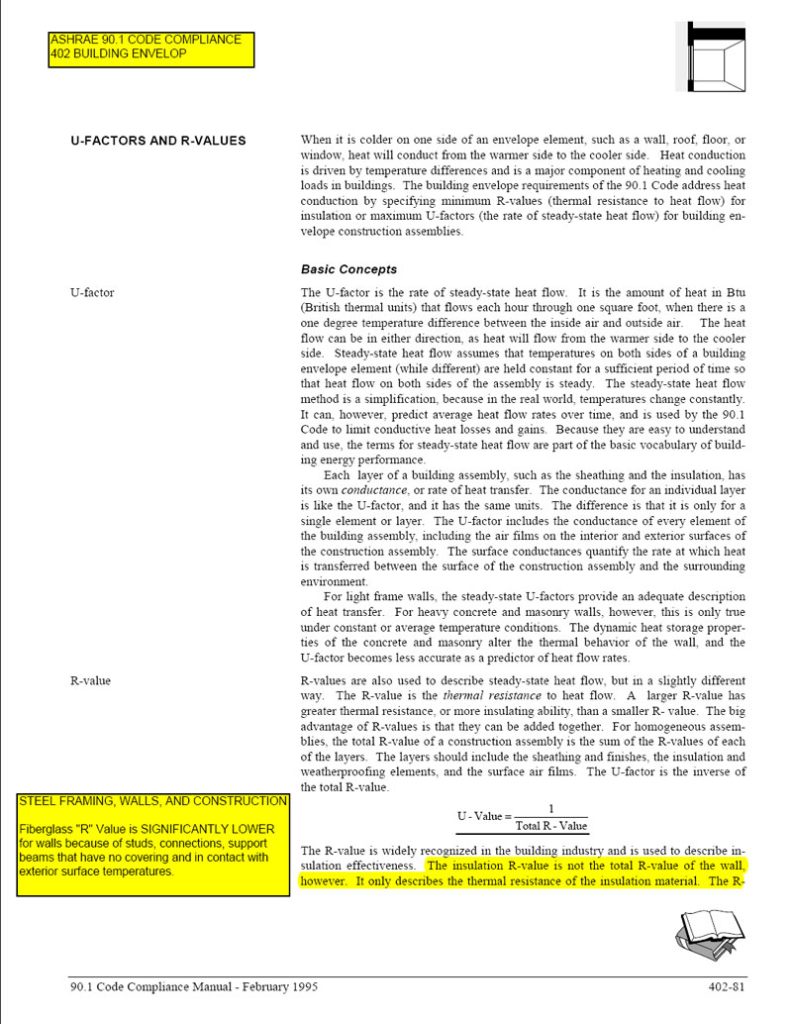

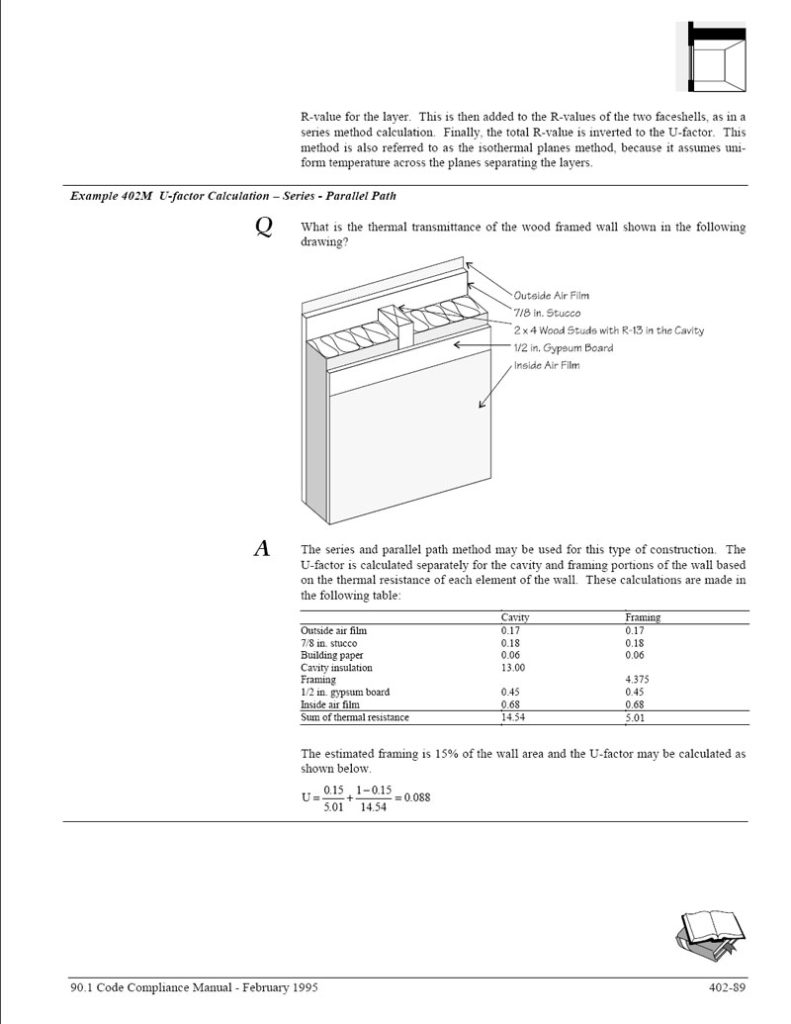
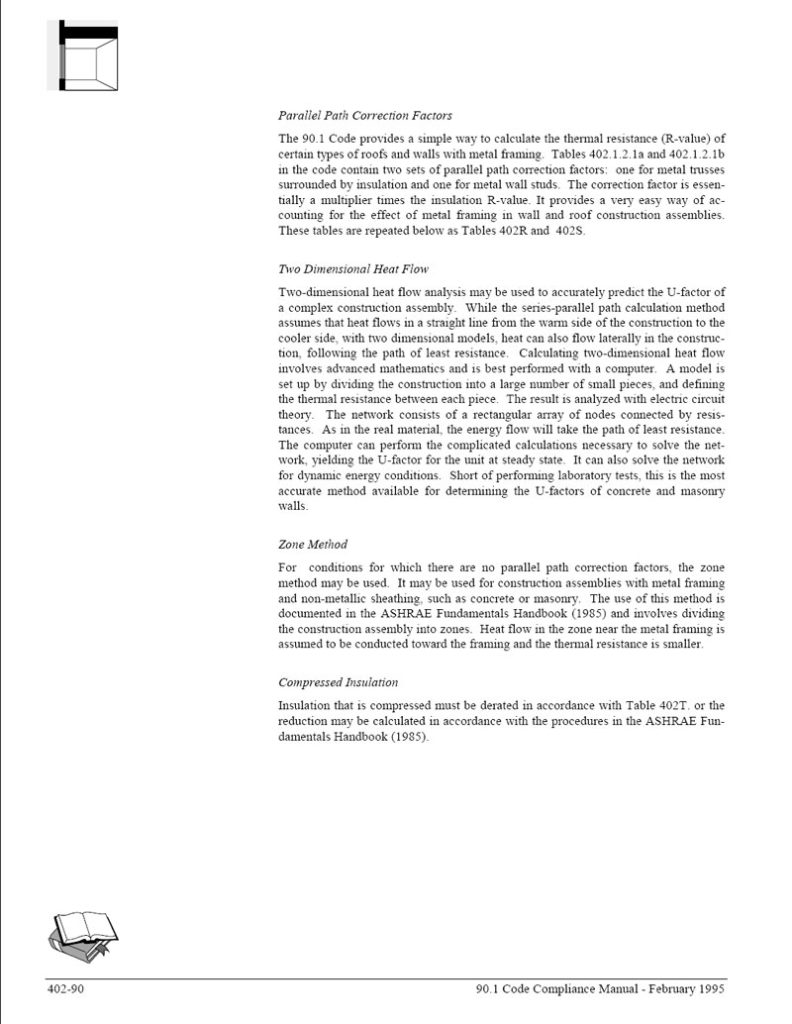
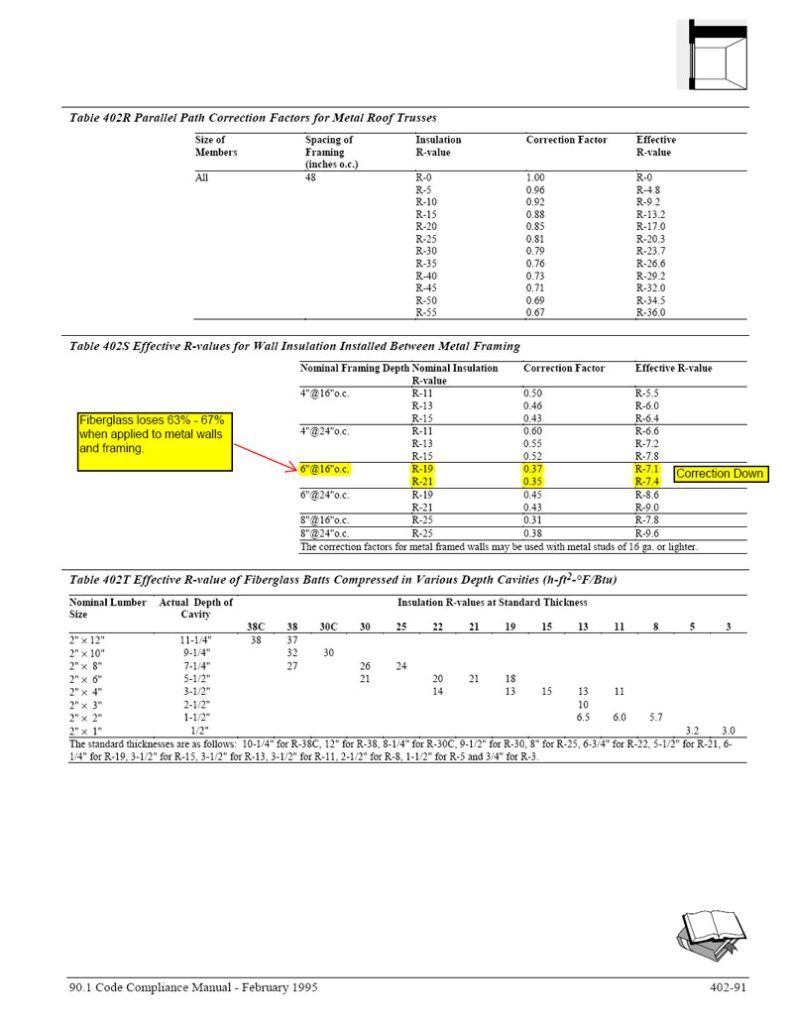
When you look at the ASHRAE tables, the message is brutal: the moment insulation becomes part of a real wall, its performance collapses. Put fibreglass in a steel frame? You lose 30% to 67% of the advertised R-value. Add sheathing, thermal bridges, cavities and fasteners? More losses again.
That’s the trap the industry keeps ignoring. Everyone quotes lab R-values measured in perfect, isolated conditions. But buildings aren’t labs – they’re systems of materials bleeding heat into each other. The envelope decides everything. And if the envelope is weak, every fancy system downstream pays the penalty.
This is why the “fabric first” principle isn’t optional. It’s the only part of a building that physics refuses to negotiate on. If the external skin is taking in heat (or losing it), no amount of mechanical tech can compensate without oversizing, overspending and wasting energy. It’s the same story the ASHRAE data tells: heat flow takes the path of least resistance, and metal, studs and sheathing override whatever R-value you thought you had.
This is where Super Therm® changes the game. Instead of relying on thickness or trapped air – the very things destroyed by framing and real-world assemblies – it prevents the heat load at the surface. No thermal bridges. No system losses. No dependency on ideal conditions. You control the envelope before the heat enters the wall, which means your mechanical systems work smaller, cheaper and more efficiently.
Instead of losing R-value once installed, Super Therm® maintains the same heat-blocking performance across every square metre of the envelope. This delivers stable, predictable heat control regardless of construction type – something bulk insulation simply cannot guarantee once it’s part of a real building. You fix the fabric first — and you block the heat at the envelope so the building stops fighting itself.
What the Real Message is from ASHRAE tables
Here’s what really matters in those ASHRAE tables – the stuff most people never read, but it changes everything about how insulation actually performs in the real world.
1. Advertised R-values are lab numbers, not system numbers
Every table shows a clear gap between:
- “stated” insulation R-value and
- “overall assembly R-value”
Once you put insulation into a wall, the whole system performs at a fraction of what the packaging claims. ASHRAE is effectively admitting that the numbers everyone markets are not the numbers buildings experience.
2. Metal framing destroys performance
ASHRAE shows metal framing can cut insulation R-value by:
- 30% in typical light-gauge metal walls
- 40–67% in some configurations
Thermal bridging through metal dominates the heat path and bypasses the insulation almost completely.
This is why bulk insulation in steel buildings underperforms – the insulation isn’t the weak link, the framing is.
3. Parallel heat paths matter more than insulation thickness
ASHRAE uses “parallel path” calculations. Meaning: heat flows through the easiest route.
If 20% of your wall is framing, that 20% controls the performance of the whole assembly.
You can double the batts and barely move the needle.
This is why the industry hasn’t solved performance gaps by “just adding more insulation.”
4. Air spaces, voids and construction realities wreck performance
ASHRAE shows reductions for:
- compressed insulation
- air gaps
- misalignment
- partial fill
- voids
- thermal short-circuits
These losses aren’t exceptions – they’re normal on real job sites.
A 10% mistake can destroy 30–40% of performance.
And that’s assuming installers are perfect. They’re not.
5. R-value does NOT account for thermal mass or diffusivity
The tables ignore:
- heat absorption
- heat storage
- time lag
- heat flow rate (diffusivity)
This is why a wall with a high R-value can still feel hot: the heat moves through the system fast.
ASHRAE knows this, but the code is based on steady-state testing that ignores real solar conditions.
6. R-value does not measure solar heat load
R-value only measures conduction.
It does NOT measure:
- infrared radiation
- solar gain
- thermal loading on the building skin
With 53% of solar energy in the IR range, that’s a massive blind spot.
7. The envelope performs as a system—not as individual components
The tables make one thing clear: the wall’s final thermal performance is not determined by insulation alone.
It’s determined by:
- surface materials
- framing
- geometry
- interfaces
- installation
- radiation
- bridging
This is why “fabric first” means envelope first, not “more insulation.”
Why this matters for Super Therm®
Super Therm® is the non-hygroscopic alternative to bulk insulation because it doesn’t absorb moisture, doesn’t trap condensation and doesn’t lose performance when the building envelope gets wet. Traditional fibreglass and mineral wool collapse the moment they take on moisture, but Super Therm® blocks heat at the surface without relying on air gaps or dry cavities. It keeps its thermal performance in real-world conditions – humid, damp, coastal, or high-condensation environments – where conventional insulation fails. Every failure mode listed above – framing, bridging, gaps, absorption, system losses – has no effect on Super Therm®.
Because it:
- blocks the heat load at the surface
- doesn’t rely on thickness
- doesn’t rely on trapped air
- doesn’t get bridged by steel
- doesn’t suffer system losses
- doesn’t lose effectiveness in real-world assemblies
Traditional insulation only works if the building is perfect.
Super Therm® works because buildings aren’t.
U Value (U-factor)
The U-factor is the rate of steady-state heat flow. It is the amount of heat in BTU (British thermal units) that flows each hour through one square foot, when there is a one degree temperature difference between the inside air and outside air. The heat flow can be in either direction, as heat will flow from the warmer side to the cooler side. Steady-state heat flow assumes that temperatures on both sides of a building envelope element (while different) are held constant for a sufficient period of time so that heat flow on both sides of the assembly is steady. The steady-state heat flow method is a simplification, because in the real world, temperatures change constantly. It can, however, predict average heat flow rates over time, and is used by the 90.1 Code to limit conductive heat losses and gains. Because they are easy to understand and use, the terms for steady-state heat flow are part of the basic vocabulary of building energy performance.
Each layer of a building assembly, such as the sheathing and the insulation, has its own conductance, or rate of heat transfer. The conductance for an individual layer is like the U-factor, and it has the same units. The difference is that it is only for a single element or layer. The U-factor includes the conductance of every element of the building assembly, including the air films on the interior and exterior surfaces of the construction assembly. The surface conductances quantify the rate at which heat is transferred between the surface of the construction assembly and the surrounding environment.
For light frame walls, the steady-state U-factors provide an adequate description of heat transfer. For heavy concrete and masonry walls, however, this is only true under constant or average temperature conditions. The dynamic heat storage properties of the concrete and masonry alter the thermal behaviour of the wall, and the U-factor becomes less accurate as a predictor of heat flow rates.
Default U-factors
Precalculated U-factors are provided in this section for typical construction assemblies, including roofs, floors, and doors. These values are calculated using acceptable methods, and may be used for compliance with the code.
R-Value
R-values are also used to describe steady-state heat flow, but in a slightly different way. The R-value is the thermal resistance to heat flow. A larger R-value has greater thermal resistance, or more insulating ability, than a smaller R- value. The big advantage of R-values is that they can be added together. For homogeneous assemblies, the total R-value of a construction assembly is the sum of the R-values of each of the layers. The layers should include the sheathing and finishes, the insulation and weatherproofing elements, and the surface air films. The U-factor is the inverse of the total R-value.
The R-value is widely recognised in the building industry and is used to describe insulation effectiveness. The insulation R-value is not the total R-value of the wall, however. It only describes the thermal resistance of the insulation material. The RU value of the entire wall assembly can be significantly lower when metal framing penetrates the insulation.
Most construction assemblies include more than one material in the same layer. For example, a wood stud wall includes cavity areas where the insulation is located and other areas where there are solid wood framing members. The wood areas have a lower R-value, and conduct heat more readily than the insulated areas. It is incorrect to neglect framing members when calculating the U-factor for the wall, roof, or floor assembly. The correct U-factor includes the insulation portion of the wall and the U-factors through the solid (or framed) portion of the wall. The 90.1 Code requires that the U-factor of each envelope assembly be calculated taking into account framing and other thermal bridges within the construction assembly.
R-value differences
To determine the effectiveness of insulation with different R-Values, we need to calculate the heat transfer rate through the insulation for each case. The formula for heat transfer through insulation is:
Heat Transfer (Q) = (Temperature Difference) / (Thermal Resistance, R-Value)
Assuming the outside ambient temperature is 30 degrees Celsius and the desired indoor temperature is 20 degrees Celsius, let’s calculate the heat transfer rate for both R-Value scenarios:
- Insulation with R-Value of 5:
- Temperature Difference (ΔT) = 30°C (outside) – 20°C (inside) = 10°C
- Heat Transfer (Q) = 10°C / 5 (R-Value) = 2 watts per square meter (W/m²)
- Insulation with R-Value of 3:
- Temperature Difference (ΔT) = 30°C (outside) – 20°C (inside) = 10°C
- Heat Transfer (Q) = 10°C / 3 (R-Value) = 3.33 watts per square meter (W/m²)
Now, let’s compare the heat transfer rates:
- For insulation with an R-Value of 5, the heat transfer rate is 2 W/m².
- For insulation with an R-Value of 3, the heat transfer rate is 3.33 W/m².
The insulation with an R-Value of 5 is more effective in this scenario because it allows for a lower heat transfer rate compared to the insulation with an R-Value of 3. This means that the insulation with an R-Value of 5 will better resist the flow of heat and help maintain a more comfortable indoor temperature with lower energy consumption for cooling purposes.









